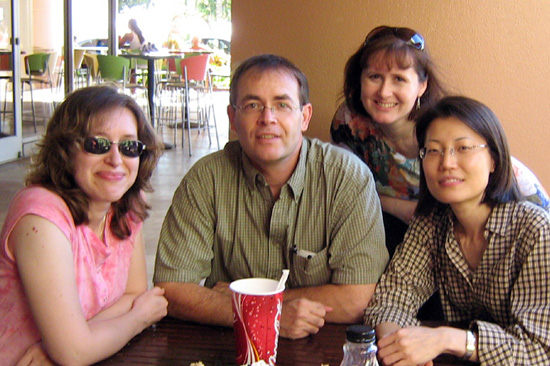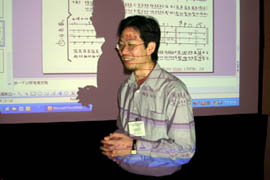Graduate Students, Alumni, Faculty Present Papers at Ethnomusicology Conference
 |
|
At left, ethnomusicology students Marzanna Poplawska, Nick Hockin, Amy Ingram and Hae Joo Kim gather during the Society for Ethnomusicologys 51st Annual Conference Nov. 16-19 in Honolulu. |
| Posted 12/20/06 |
| Nine Wesleyan graduate students studying ethnomusicology ended a recent conference on a high note.
Each student presented papers at The Society for Ethnomusicologys 51st Annual Conference Nov. 16-19 in Honolulu. This years topic was Decolonizing Ethnomusicology. The annual convention is the focal point of the year; these meetings offer a great chance to network with fellow grad students, eminent senior scholars, and former alums, says Mark Slobin, professor of music. In addition, this is a record-breaking number of graduate students that presented. Thembela Vokwana presented Can We Sing Together? Performing Nationhood through Choral Festivals in South Africa. Andrew Dewar presented “Sonic Explorations: On the Analysis of Intercultural Experimentalism; Marzanna Poplawska presented Diaspora or not yet–Indonesian Christians in the USA; and Junko Oba presented 2 Hae Joo Kim presented “Riding the Wave of Nostalgia and Melodrama through Dae Jang Geum; Po-wei Weng presented The Survival of Oral Tradition in a Modernizing Genre: ‘Oral Notation’ in Taiwan’s Peking Opera Percussion Music; Ian Eagleson presented Rural Popular Music and Ethnic Identity: Benga Dance Bands of the Luo Community in Western Kenya; Chris Miller presented “Indonessian Musik Kontemporer and the Issue of ‘Western Influence; Vincenzo Cambria presented Decolonizing the Archive: Documentation and the Production of Knowledge in a Participatory Ethnomusicological Research in Rio de Janeiro, Brazil. Amy Ingram presented “Parang: Finding a Place for Spanish Creole Identity in the Trinidadian National Calendar; and Nicholas Hockin presented “Drums, Headscarves, and Mothers’ Dances at Weddings in Bamako, Mali: Local Change on the Margins of Globalization; This was Hockin’s second time presenting a paper at the SEM conference. This year, the Ph.D. candidate in ethnomusicology, presented segments of his dissertation, which is scheduled to be completed next year. “Presenting our ideas in paper sessions allows us a chance to get vital feedback from our peers, not to mention developing public speaking skills. Networking is an integral aspect of the conference, enabling members to share personal and professional insightsthat broaden our understanding of the field and of each other,” Hockin says. “And we develop a sense of what the latest trends are by checking out presentations, reading paper topic titles and abstracts, and by browsing and/or buying books. In addition to the students, Slobin and Su Zheng, associate professor of music and East Asian studies, chaired panels at the conference. Eric Charry, associate professor of music and Rob Lancefield, manager of Museum Information Services and registrar of collections at Davison Art Center presented papers. Sumarsam, chair of the Music Department and adjunct professor of music, attended the conference, along with several students and recent alumni. The nine graduate students are among 22 current students studying music. They are an unusually varied group, Slobin explains, including students from Brazil, China, South Africa, Ghana, Mexico, Taiwan and Canada. They are part of the 46-year old program’s interest in drawing the widest spectrum of students from among the substantial pool of applicants; selectivity runs at about 20 percent. The Music Department faculty wants their students to be well rehearsed, so prior to the conference, they drill the students in the skills of preparing a paper abstract, developing a quality 20-mimute presentation, and delivering it in a lively and well-organized way. Usually our students’ papers stand out for the attentive response they draw from listeners, as opposed to the many droning, rapid-fire, or inaudible papers we sit through at the dozens of panels, explains Slobin, pictured at left, center. Wesleyan ethnomusicology Ph.D candidate Amy Ingram has attended a few SEM conferences in the past, but this was her first time presenting at the conference, and her first time presenting her dissertational material to her peers. I think that the conference is certainly a necessary rite of passage for all grad students, Ingram explains. It helps us all to gain the perspective of how our learning experience at Wesleyan compares to other graduate programs. Receiving feedback from peers and committee members certainly reinvigorated my motivation to keep writing, and meeting others during the social moments between panels was really beneficial. Following the conference, the Wesleyan affiliates held a party to draw the past and present students together. In 2008, the SEM convention will be held at Wesleyan in the new Susan Lemberg Usdan University Center. |
| By Olivia Drake, The Wesleyan Connection editor. Photos contributed. |


 80,000 Invisible Men: Music, Identity, and the Story of Nikkei/Zainchi Brazilian Community in Japan, Summer 2005.
80,000 Invisible Men: Music, Identity, and the Story of Nikkei/Zainchi Brazilian Community in Japan, Summer 2005.